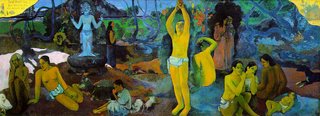Paul Gauguin

Paul Gauguin, born on this day in 1848 in Paris, was the son of a French journalist and his Peruvian wife, and the grandson of feminist novelist/journalist Flora Tristan. Brought up in Lima, he joined the merchant marines as a teen but eventually returned to Paris to marry and become a successful stockbroker.
He might have been a content member of the bourgeoisie, with 5 children and a respectable career, were it not for his visit to First Impressionist Exhibition in 1874. He was so transfixed by the experience that he promised himself that he would become a painter, and he befriended one of the artists on display there, Camille Pissarro. Pissarro advised Gauguin to "look for the nature that suits your temperament," whereupon Gauguin promptly painted a landscape in Pissarro's style and had it accepted at the Salon in 1876. His encounters with Cezanne led him to down the road to a new, more personal style, which he had more time to develop when his bank laid him off during the recession of 1883; from 1884 onwards, he painted full time.
Settling first in Rouen, he eventually abandoned his family and retreated to the artist's colony at Pont-Aven (with interludes in Panama and Martinique), there producing one his first important works, Vision after the Sermon: Jacob Wrestling with the Angel (1888), showing a desire to return to pre-Renaissance sources for a restored primitive sense of composition (in which time and space could no longer be represented with the illusion of objectivity), combined with an exotic, intense, flat coloration derived perhaps from the art he had encountered in the Southern hemisphere. Gauguin explained his new style as a "synthesis" of remembered experiences rather than a depiction of something perceived in nature, a concept eventually adopted in the critical literature as Symbolism or Synthetism.
After a short, unfortunate visit with Van Gogh at Arles, Gauguin's interest in primitive forms became mirrored in his desire for a primitive lifestyle: in 1891, he held an exhibition of his own work with the goal of selling enough paintings to finance a trip to Tahiti, where he could survive on "ecstasy, calmness and art." With 10,000 francs from the exhibition, he left for Tahiti, where his artistic primitivism matured while his hope for salvation in a primitive life was disappointed -- leading him to attempt suicide in 1897.
In paintings such as Two Tahitian Women (1899), his colors became more harmonious, and his interests seem to shift to the delight of painting beautiful bodies and faces, while pieces such as Spirit of the Dead Watching (1892) and Where Do We Come From? What Are We? Where Are We Going To? (1897) combine such meditations on beauty and line with enigmatic portrayals of primitive faith in flux. In 1901 he left Tahiti for the Marquesas, where he died on May 8, 1903, impoverished and syphilitic.
Labels: Painting and Sculpture





0 Comments:
Post a Comment
Subscribe to Post Comments [Atom]
<< Home